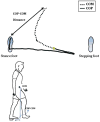Knee extensor strength, dynamic stability, and functional ambulation: are they related in Parkinson's disease?
- PMID: 20382292
- PMCID: PMC3607197
- DOI: 10.1016/j.apmr.2009.11.026
Knee extensor strength, dynamic stability, and functional ambulation: are they related in Parkinson's disease?
Abstract
Objective: To evaluate the relationship between knee extensor strength, postural stability, functional ambulation, and disease severity in Parkinson's disease (PD).
Design: A cohort study.
Setting: University research laboratory.
Participants: Patients (N=44) with idiopathic PD.
Intervention: Not applicable.
Main outcome measures: Participants were evaluated on their isokinetic knee extensor strength. Additionally, participants completed an assessment of their postural stability (Functional Reach Test for static stability and a dynamic postural stability assessment as measured by the center of pressure-center of mass moment arm during gait initiation). Participants also underwent an evaluation of their functional ambulation as measured by a 6-minute walk test. Lastly, participants were evaluated by a neurologist specially trained in movement disorders to assess neurologic status and disease severity using the Unified Parkinson's Disease Rating Scale and the Hoehn and Yahr disability score.
Results: Knee extensor strength positively correlated with dynamic postural stability and negatively correlated with disease severity. Further, dynamic postural stability was negatively correlated to disease severity and positively correlated with functional ambulation in this cohort of patients with PD (P<.05). The results also suggest that the Functional Reach Test may be a valuable assessment tool to examine postural stability in PD.
Conclusions: These findings suggest a malleable relationship between knee extensor strength, dynamic stability, and disease severity in PD. Although strength is only one piece of the puzzle in the functional outcome of PD, these findings may assist clinicians in designing appropriate interventions aimed at increasing function and decreasing fall risk in PD.
Copyright 2010 American Congress of Rehabilitation Medicine. Published by Elsevier Inc. All rights reserved.
Conflict of interest statement
No commercial party having a direct financial interest in the results of the research supporting this article has or will confer a benefit on the authors or on any organization with which the authors are associated.
Figures
References
-
- Ashburn A, Stack E, Pickering RM, Ward CD. Predicting fallers in a community-based sample of people with Parkinson’s disease. Gerontology. 2001;47:277–81. - PubMed
-
- Genever RW, Downes TW, Medcalf P. Fracture rates in Parkinson’s disease compared with age- and gender-matched controls: a retrospective cohort study. Age and Ageing. 2005;34:21–4. - PubMed
-
- Sousa N, Sampaio J. Effects of progressive strength training on the performance of the Functional Reach Test and the Timed Get-Up-and-Go Test in an elderly population from the rural north of Portugal. Am J Hum Biol. 2005;17:746–51. - PubMed
-
- Schlicht J, Camaione DN, Owen SV. Effect of intense strength training on standing balance, walking speed, and sit-to-stand performance in older adults. J Gerontol A Biol Sci Med Sci. 2001;56A:M281–6. - PubMed
Publication types
MeSH terms
Grants and funding
LinkOut - more resources
Full Text Sources
Other Literature Sources
Medical


